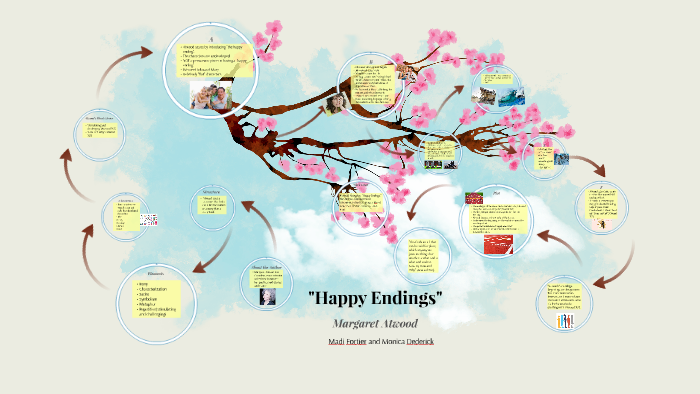
I do know what I’d been thinking about – or more specifically, what I was consuming – in the lead up to my grandiose statement.Īt that time my fiction diet included a lot of sci-fi. The subconscious is as mysterious a place as prehistory. Like when people guess at what Stonehenge was for. The truth is, when people ask (and they always do) where I got the idea for my book. He’s been with me twenty years, and is used to grandiose statements. I don’t remember what prompted me to make my grandiose statement. I think there were leaves on the ground, though those could have been from another walk memory that I’ve merged with this one. I was walking home from the shop with my partner. ‘I reckon I could write a speculative fiction novel.’
HAPPY ENDINGS MARGARET ATWOOD INSPIRATION HOW TO
Next Section Sections A – C Summary and Analysis Previous Section Themes Buy Study Guide How To Cite in MLA Format GradeSaver "Happy Endings Quotes and Analysis". Instead, the narrator tells readers to think about the specific relationships between characters, dialogue, motivations, settings, imagery, contextual implications, and other literary elements that define memorable storytelling and good fiction.

In this final section of the story, the narrator reminds readers that death is inevitable, and that focusing solely on plot while storytelling will only lead a writer to the deaths of characters. Now try How and Why." Narrator, Version F "That's about all that can be said for plots, which anyway are just one thing after another, a what and a what and a what. Here, the author playfully posits storytelling and story writing as a type of mad-lib, only made compelling by the addition of other elements beyond plot. In so doing, the narrator suggests that the story will not actually change because mortality is inevitable. Here, the narrator addresses the reader directly and encourages them to replace some of the words in the preceding story with new ones. "If you like, it can be 'Madge,' 'cancer,' 'guilty and confused,' and 'bird watching.'" Narrator, Version E The repetition of this description underscores the blandness and monotony associated with "happiness," ultimately suggesting that "happy endings" do not create good stories. Here, the language describing John and Madge's relationship is almost identical to that describing John and Mary's happy marriage in version A. Readers will likely begin to notice that the narrator often repeats words and phrases throughout each version of the story. "John is married to a woman called Madge and they have two children, a charming house which they bought just before the real estate values went up, and hobbies which they find stimulating and challenging, when they have the time." Narrator, Version C Furthermore, the use of similes in this quotation emphasizes how this version of John and Mary – which is more fraught with sadness and struggle – is likely more interesting and complex than version A, where they had a "happy ending." Here, the narrator describes Mary's thoughts about John and highlights the gender normative behavior at work in their relationship. In this story, Mary is devoted to a selfish John who takes advantage of her and eventually has an affair with Madge. This other John will emerge like a butterfly from a cocoon, a Jack from a box, a pit from a prune, if the first John is only squeezed enough." Narrator, Version B "Inside John, she thinks, is another John, who is much nicer. The monotony of this account suggests that the happy life John and Mary led does not actually yield an interesting or compelling story at all.

Here, she once again draws attention to the fact that she is curating a story, announcing the conclusion with John and Mary's deaths.

The narrator describes John and Mary's happy marriage and fulfilling life together. This is the end of the story." Narrator, Version A
HAPPY ENDINGS MARGARET ATWOOD INSPIRATION SERIES
This introduction establishes the sense of irony that will continue throughout the story, wherein the plot is not a fixed series of events but instead shifts according to the whims of a frustrated writer. Here, the narrator shows that she is speaking directly to someone (the reader) and encouraging them read the story as experimental and changing.

"If you want a happy ending, try A." NarratorĪfter introducing John and Mary, the narrator encourages the reader to question what happens next to these two characters.


 0 kommentar(er)
0 kommentar(er)
